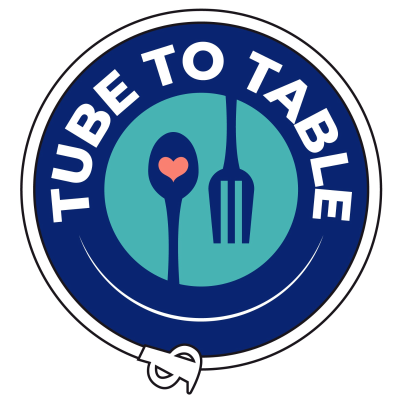
Tube to Table
Englisch
Gratis en Podimo
Kostenlos hören bei Podimo
Starte jetzt und verbinde dich mit deinen Lieblingspodcaster*innen
- Vertraut von über 1 Mio. deutschen Hörer*innen
- Über 1.000 lokale Podcasts und Shows – nur bei Podimo
- Keine Zahlung nötig
Mehr Tube to Table
Helping tube-fed kids become happy and healthy eaters.
Alle Folgen
62 FolgenS2, Ep. 18: Choosing a Program
Heidi and Jennifer are back today to help you feel empowered to choose the right tube weaning program for your child, your family, and yourself. Choosing a tube-weaning program is a major decision for families, especially when the information available can feel scattered or confusing. At the heart of this choice is your child’s safety, both physical and emotional. A solid program should prioritize medical oversight, work collaboratively with your child’s healthcare team, and have clear safety parameters in place for monitoring hydration, growth, and overall wellbeing. Just as important is your experience as the parent! Feeding is deeply tied to how we parent and connect with our kids, and when it becomes stressful or uncertain, that impact matters. You should be an active participant in the process, supported by professionals who listen to your insights, respect your instincts, and protect the relationship you have with your child. It’s also essential to consider the environment where the learning will take place. Many children do best in spaces that feel familiar and low-stress, which is why home-based approaches can be so powerful. They allow clinicians to see the real factors influencing feeding and help kids practice skills where they will ultimately use them. Inpatient or clinical programs can offer benefits too, like on-site medical support and multidisciplinary teams, but it’s important to understand what mealtimes will look like and how they plan to help your child generalize those gains back home. Virtual programs are convenient, but even if the communication is virtual, tube weaning is still a very real part of your child's health journey. Virtual programs should prioritize safety, adapt to your child’s unique needs, offer timely communication, and avoid a one-size-fits-all model. Whatever the setting, the program should be flexible, child-led, and ready to pivot when challenges or “what if” moments arise. ** Please remember this podcast is NOT meant to replace the support and guidance of your child's medical team. Consult with your doctor before starting the weaning process.** Don’t forget to follow us on social media for more helpful information @Thrivewithspectrum on Instagram and Thrive by Spectrum Pediatrics on Facebook. You can also find out more information about the programs we offer at www.thrivewithspectrum.com
S2, Ep. 17: How to Feed Kids Responsively
Heidi and Jennifer are back! This week, they are sharing some tips and important pillars for feeding kids responsively. When children are learning to eat after having been tube dependent, it’s easy to focus on hunger only, but true progress comes from safety, comfort, and connection first. Eating isn’t just about what’s on the plate! It’s shaped by the environment, communication and language around eating and feeding, and how your child feels. Before thinking about what foods to offer, we encourage you to start by noticing who your child is outside of mealtimes. How do they handle new situations? Noise? Mess? These clues help you shape a mealtime experience that feels predictable and safe, which is where learning to eat begins. Early on, comfort and enjoyment matter more than how much your child eats. Food is new and can feel hard, so try to focus on helping your child feel secure and curious before volumes and varieties. That might mean sitting together on the floor, offering familiar snack foods, or keeping mealtimes playful and low-pressure. Remember the Division of Responsibility. You decide what, when, and where to offer food, and your child decides if and how much to eat. It’s about providing structure while allowing freedom, so your child can explore food at their own pace. Progress in tube weaning certainly isn’t linear. It’s a process of discovery. Some days will go smoothly and others won’t, and that’s okay. Reflect on what you notice, stay flexible, and keep comfort at the center of the oral eating experiences. When you focus on safety, connection, and responsiveness instead of consumption, you create the foundation your child needs to build trust with food and eventually eat with confidence and joy. ** Please remember this podcast is NOT meant to replace the support and guidance of your child's medical team. Consult with your doctor before starting the weaning process.** Don’t forget to follow us on social media for more helpful information @Thrivewithspectrum on Instagram and Thrive by Spectrum Pediatrics on Facebook. You can also find out more information about the programs we offer at www.thrivewithspectrum.com [https://www.thrivewithspectrum.com/]
S2, Ep. 16: Tools, Cups & Utensils
Parents often ask us: What tools do I need to help my child eat? From vibrating toys to chewy tubes, special spoons to miracle cups, the pressure to “pick the right thing” during tube weaning can be overwhelming. But the truth is, responsive tube weaning isn’t about finding the perfect tool, it’s about understanding and supporting your unique child. In this episode of Tube to Table, we unpack the role of tools, cups, and utensils in the weaning process. We’ll talk about: * Why tools are often recommended in feeding therapy and why we rarely use them * The myth of “sensory tolerance” and what’s actually happening when kids seem sensitive * Why oral motor tools don’t mimic how food behaves, and how that impacts learning * What it means to honor a child’s identity to support true felt safety * How to approach cups and utensils in a way that builds autonomy and agency We’ll also share when tools can be useful and how to know if your child is inviting them in, rather than just tolerating them. This conversation is a reminder that your child is the best guide. Most of the time, the tools you need are already at home and the real work is in creating a safe, responsive environment where your child can explore, lead, and learn to eat on their own terms. ** Please remember this podcast is NOT meant to replace the support and guidance of your child's medical team. Consult with your doctor before starting the weaning process.** Don’t forget to follow us on social media for more helpful information @Thrivewithspectrum on Instagram and Thrive by Spectrum Pediatrics on Facebook. You can also find out more information about the programs we offer at www.thrivewithspectrum.com [https://www.thrivewithspectrum.com/]
S2, Ep. 15: Growth in Tube Weaning
In this episode, Jeni and Heidi unpack a common concern in the tube weaning journey: growth. Fears about weight loss and strategies to facilitate weight gain all impact your child's ability to wean. While growth is important, Heidi and Jeni are here today to explore why it's essential to look at it in the context of the whole child, not just the number on the scale. Jeni and Heidi talk about how focusing only on weight can lead to confusion and even stall the weaning process. Attempts to “plump kids up” before a wean often set them up for sharper drops later. Growth charts, while useful at times, weren't based on kids with tubes or complex medical histories, and comparing your child to a chart made for someone else doesn't tell the full story. Instead, we encourage families and providers to track trends over time, compare children to themselves, and zoom out to see the bigger picture. Weight loss during weaning can feel scary, but it's often a necessary and expected part of the process. When carefully monitored, it’s a sign that the child’s body is learning hunger cues and beginning to build a more natural, responsive relationship with food. Trusting the process and staying responsive rather than reacting out of fear helps children build lasting skills and confidence as oral eaters. Ultimately, growth matters, but it's just one piece of the puzzle. When we prioritize quality over quantity, work closely with our team, and keep weight in perspective; children are better able to thrive both on the scale and at the table. ** Please remember this podcast is NOT meant to replace the support and guidance of your child's medical team. Consult with your doctor before starting the weaning process.** Don’t forget to follow us on social media for more helpful information @Thrivewithspectrum on Instagram and Thrive by Spectrum Pediatrics on Facebook. You can also find out more information about the programs we offer at www.thrivewithspectrum.com
S2, Ep. 14: Hydration During Tube Weaning
In this episode, Jeni and Heidi dive into a topic that doesn’t always get the spotlight it deserves during the tube weaning process: hydration. Hydration is a crucial and separate process with its own cues, rhythms, and strategies. Understanding hydration and its importance separate from nutrition and supplementation can often lead to a safer and smoother wean. We talk about why hydration deserves focused attention, especially in the early stages of weaning when safety is the top priority. How do you know your child is hydrated enough if they’re no longer getting fluids through a tube? We unpack the signs beyond just milliliters—wet diapers, energy levels, tear production, skin quality—and why it’s so important to ask your medical team for individualized hydration parameters. You'll also hear why keeping a child well hydrated often helps the feeding process, rather than hurt it. Hydration supports energy, digestion, and the body's ability to regulate. Jeni and Heidi also explore when to start working on oral hydration, and why this usually comes a little later in the weaning journey. They’ll also talk about how to build safe, joyful routines around drinking, from modeling (hint: kids love drinking what you’re drinking!) to loosening our adult ideas of “the right drink.” ** Please remember this podcast is NOT meant to replace the support and guidance of your child's medical team. Consult with your doctor before starting the weaning process.** Don’t forget to follow us on social media for more helpful information @Thrivewithspectrum on Instagram and Thrive by Spectrum Pediatrics on Facebook. You can also find out more information about the programs we offer at www.thrivewithspectrum.com















































